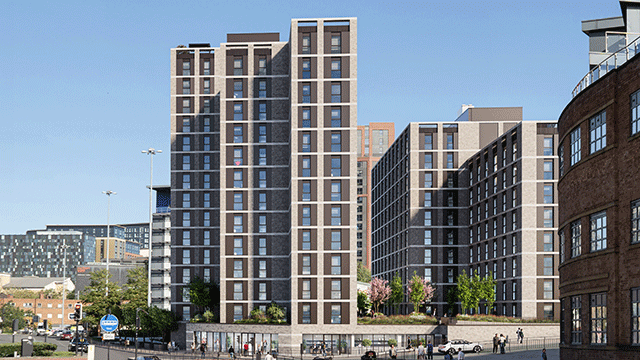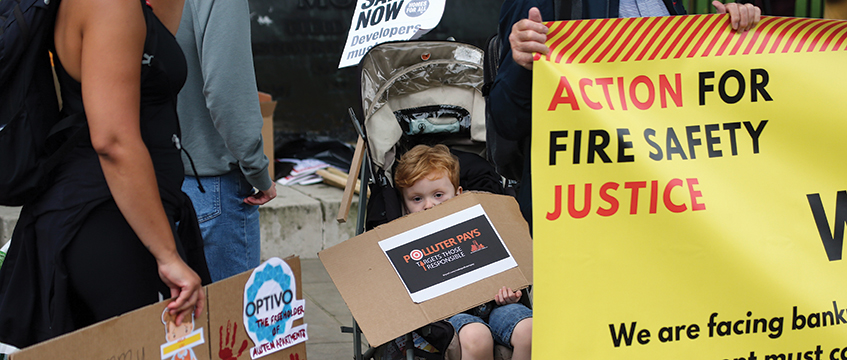Landlord and tenant — Scope of covenant for quiet enjoyment in subunderlease where complaint was interference with subunderlessees’ business by erection of scaffolding by superior lessors — New point decided by judge — Subunderlessees were retailers of clothing and alleged that the scaffolding obstructed the view of the shop by passers-by and caused loss of business — Covenant in subunderlease was in the form against ‘any interruption by the landlord or any person or persons lawfully claiming through under or in trust for the landlord’, but the expression ‘the landlord’ was defined in a subsequent clause as including ‘the superior lessors’ — Whether covenant, with this extended definition,
covered any interruption of the plaintiff subunderlessees’ enjoyment, lawful or unlawful, or whether it covered only lawful acts, leaving the subunderlessees to sue the superior lessors in tort for any damage occasioned by their unlawful acts — Judge’s analysis of scope and application of covenant — Consideration of Owen v Gadd, Sanderson v Mayor of Berwick-on-Tweed, Williams v Gabriel and Nash v Palmer — Distinction between a covenant against interruptions expressed generally and a covenant against interruptions by a named person — In former case liability extends only to lawful interruptions, but in the latter covers interruptions whether lawful or unlawful — In the present case there was not a ‘named’ person in the sense of an identified individual, as in Nash v Palmer and similar cases, but the expression ‘superior lessors’ was an identification by reference to a particular interest in the property, namely, the present superior lessors or their successors in title for the time being as owners of the reversion expectant on the term granted by the underlease — The judge held that the ‘named person’ rule could be interpreted in this manner and therefore decided that the defendant subunderlessors were liable for acts of the superior lessors which constituted an interruption of the subunderlessees’ enjoyment, whether the acts were lawful or unlawful
In this
summons the plaintiffs, Queensway Marketing Ltd, raised a short point of
construction of a covenant for quiet enjoyment in a subunderlease granted to
them by the defendants, Associated Restaurants Ltd, who were themselves
underlessees of part of premises of which the head lessees were Norwich Union
Insurance Group (Pensions Management) Ltd. The subunderlease was of a shop at
Premier House, 150 Southampton Row, London WC1.
A H Norris
(instructed by Fremont & Co) appeared on behalf of the plaintiffs; D J A di
Mambro (instructed by Adlers) represented the defendants.
Giving
judgment, MR E G NUGEE QC said: This summons raises a short point on the
construction of a landlord’s covenant for quiet enjoyment in a subunderlease of
a shop at Premier House, 150 Southampton Row, London WC1. I am told that the
summons is a preliminary to larger-scale litigation that is contemplated, and
the point which it raises is in effect a preliminary point of law.
Premier House
comprises a basement, a ground floor on part of which there are a shop and a
restaurant, and a number of upper floors containing office and residential
accommodation. The head lease of the building is vested in Norwich Union Insurance
Group (Pensions Management) Ltd, whom I will call ‘the Norwich Union’. They
underlet the ground-floor shop and restaurant and the basement beneath them to
the defendants, Associated Restaurants Ltd, by an underlease dated April 29
1977 for a term of 20 years from December 25 1976. The defendants in turn
subunderlet the shop and the basement to the plaintiffs, Queensway Marketing
Ltd, by a subunderlease dated August 17 1979 for 20 years less 10 days from
December 25 1976. The plaintiffs carry on the business of retailers of ladies’
and men’s clothing and accessories in the shop.
In July 1982
the Norwich Union erected scaffolding along the face of the building outside
the plaintiffs’ shop, and this scaffolding is still in position, nearly two
years later. It is common ground that the base of the scaffolding rests on the
highway. It is said by the defendants that the scaffolding was originally
erected as an emergency measure because the masonry of the upper part of the
building was crumbling and there was a danger to passers-by. It is said by the
plaintiffs that the scaffolding obstructs the passers-by’s view of the shop
window and has the effect of guiding them away from the shop window, and that
it interferes with access to the shop and has an appreciable effect on the
business of the shop. The plaintiffs claim that the erection of the scaffolding
constitutes an interruption of their quiet enjoyment of the premises demised to
them, and a breach of the defendants’ covenant for quiet enjoyment contained in
the subunderlease, for which they are entitled to recover damages from the
defendants. The covenant is contained in clause 3(1) of the subunderlease which
is as follows:
That the
Tenant may peaceably hold and enjoy the demised premises during the said term without
any interruption by the Landlord or any person or persons lawfully claiming
through under or in trust for the Landlord.
At first sight
the covenant does not extend to acts of the Norwich Union, who were responsible
for the erection of the scaffolding. However, clause 6(4) contains a definition
of the expression ‘landlord’ which is in the following terms:
The
expression ‘the Landlord’ includes the successors in title of the Landlord and
shall be deemed to include the Superior Lessors and in particular but without
prejudice to the generality hereof all consents or approvals required by the
Tenant from the Landlord shall where appropriate be deemed to include a
requirement to obtain the consent of the Superior Lessors and the Superior
Lessors have the same rights of entry as the Landlord.
The summons as
originally issued raised the question whether on the true construction of
clause 3(1) the defendants were liable for an interruption to the plaintiffs’
quiet enjoyment of their premises occasioned by the superior lessors; but it is
conceded by the defendants that the answer to that question is that in certain
circumstances the defendants are liable, because the word ‘landlord’ where it
first appears in clause 3(1) carries the extended meaning given to it by clause
6(4).
Before me the
summons was amended to raise a further question, namely, whether on the true
construction of clause 3(1) the defendants are liable for every act of the
superior lessors, lawful or unlawful, which constitutes an interruption of the
plaintiffs’ enjoyment of their premises, or whether they are liable only for
lawful acts, leaving the plaintiffs to sue the superior lessors in tort for
damage occasioned by their unlawful acts.
I was referred
to the decision of the Court of Appeal in Owen v Gadd [1956] 2 QB
99, which shows that the erection of scaffolding can in some circumstances
constitute an interference sufficiently physical and direct to be a breach of a
landlord’s covenant for quiet enjoyment. Mr di Mambro, counsel for the defendants,
did not accept that, if the covenant in the present case imposed liability on
the defendants for every act of the superior lessors, it necessarily followed
that the erection of the scaffolding in the present case constituted a breach;
for if the evidence showed that the Norwich Union were acting to protect their
tenants and the other occupiers of the property from the danger of falling
masonry, it may be that the court would come to a different conclusion from
that which the Court of Appeal reached in Owen v Gadd. That,
however, is a matter on which I am not called upon to express an opinion in
this action.
Since it is
agreed that the expression ‘the Landlord’ in clause 3(1) of the subunderlease
must be given an extended meaning which includes the superior lessors, it might
be thought that the language of the covenant was clear and its construction was
straightforward, and that the defendants were liable for any interruption of
the plaintiffs’ enjoyment of their premises which was caused by the superior lessors,
whether such interruption was lawful or unlawful. The matter is not, however,
as simple as that, for the construction of covenants for quiet enjoyment has
been the subject of a long line of authorities stretching back at least to the
16th century, and the covenant in the present case must be construed in
accordance with the principles which emerge from those authorities.
A covenant for
quiet enjoyment is primarily a covenant for title; that is to say, its primary
purpose is to protect the lessee against defects in the title conferred by the
lease which arise from previous dealings with the demised premises by the
lessor. As such it has its counterpart in the covenant for quiet enjoyment
which is one of the covenants for title given by a vendor of land who conveys
as beneficial owner. In the case of a covenant for quiet enjoyment contained in
a lease, however, three points have long been established by the authorities:
(1) The interruption contemplated by the covenant
need not necessarily be an interference with the title, but may extend to an
interference with the enjoyment: Sanderson v Mayor of
Berwick-on-Tweed (1884) 13 QBD 547.
(2) Where the covenant is qualified in the normal
manner, by being confined to interruptions by the lessor and persons claiming
under the lessor, the lessor’s liability for interruptions caused by persons
claiming under him is confined to lawful interruptions; and this is so whether
the covenant is worded so as to extend to interruptions by any person lawfully
claiming under the lessor, as in the present case, or to interruptions by any
person claiming under the lessor. The omission of the word ‘lawfully’ makes no
difference; for the words ‘any person claiming under the lessor’ are
interpreted to mean a person claiming under the lessor a right to do the acts
which caused the interruption. This was decided in Williams v Gabriel
[1906] 1 KB
premises . . . without any interruption or disturbance by the lessor or any
person claiming under him’. Bray J explained the effect of the covenant as
follows at p 158:
It comes to
this, that the lessor agrees to become bound for any act of interruption by
himself or by any person whom he has expressly or impliedly authorized to do
the acts. If the lessor parts with the property or with adjoining property to a
person, and that person is in a position to rightfully claim under his title
from the lessor that he is authorized to do those acts, the lessor will be responsible.
This is reasonable and is what the parties might well have contemplated,
because the lessor has really authorized the acts to be done; but to hold that
the parties contemplated that the lessor was to be responsible for wrongful or
negligent acts which he had not authorized would, in my judgment, be beyond
reason.
(3) In the unusual case, such as the present,
where the lessor’s covenant extends to interruptions by persons other than
those claiming under him, a distinction has been drawn between a covenant
against interruptions by all other persons, and a covenant against
interruptions by a named person. In the former case, the lessee is liable only
if the interruption is lawful, but in the latter case he is liable whether the
interruption is lawful or unlawful. The reason for this distinction appears
from the judgment of Lord Ellenborough CJ in Nash v Palmer (1816)
5 M & S 374. In that case the defendant had given the plaintiffs a bond
conditioned on his indemnifying them against the acts of one T Times. The
plaintiffs were wrongfully evicted by Times and sued on the bond. The defendant
argued that the condition was only against the rightful, and not against the
wrongful, entry of Times, but this contention was rejected. At pp 379-380 Lord
Ellenborough said this:
The question
on the first plea is, as to the extent of the defendant’s undertaking to
indemnify; as to which the rule has, I think, been correctly stated at the bar,
that where a man covenants to indemnify against all persons, this is but a
covenant to indemnify against lawful title. And the reason is, because, as it
regards such acts as may arise from rightful claim, a man may well be supposed
to covenant against all the world; but it would be an extravagant extension of
such a covenant, if it were good against all the acts which the folly or malice
of strangers might suggest; and, therefore, the law has properly restrained it
within its reasonable import; that is, to rightful title. It is, however,
different where an individual is named; for, there, the covenantor is presumed
to know the person against whose acts he is content to covenant, and may,
therefore, be reasonably expected to stipulate against any disturbance from
him, whether by lawful title or otherwise.
Bayley J said
at pp 381-382:
The
authorities cited by my brother Hullock establish this principle, that if there
be a covenant or obligation to indemnify against the acts of a person
specified, it is good against the obligor, whether the eviction be by lawful
title or not.
In the present
case the covenant is against the acts of the superior lessors, by which must be
meant the Norwich Union or their successors in title, owners for the time being
of the reversion expectant on the determination of the term granted by the
underlease to the defendants. Mr di Mambro submitted that this was not a
covenant against the acts of a named individual but a covenant against the acts
of a class of persons, and that in such a case, as in Williams v Gabriel,
the lessor should not be taken to be covenanting against wrongful acts. Mr
Norris, for the plaintiffs, submitted that the restrictive interpretation
placed on covenants against the acts of persons claiming under the lessor had
no application where the covenant was against the acts of the superior lessors.
The defendants knew what their rights were against the superior lessors when
they entered into their covenant, and could frame their covenant accordingly.
If the matter was evenly balanced, the covenant should be construed most
strongly against the covenantor.
In my judgment
the construction for which the plaintiffs contend is correct. A covenant for
quiet enjoyment is, as I have said, primarily a covenant for title. Where the
lessor covenants against the acts of all the world, it is clear that his
covenant extends only to lawful acts and amounts to a covenant that no one in
the world has a lawful right to interpret the lessee’s quiet enjoyment of the
demised premises. Similarly, where the lessor covenants against the acts of all
persons claiming under him, his covenant extends only to lawful acts and
amounts to a covenant that he has not authorised anyone to interrupt the
lessee’s quiet enjoyment of the demised premises. But where the lessor
covenants against the acts of a single identifiable person, whether he is named
in the covenant or defined by reference to his interest in the property of
which the demised premises form part, the covenant must in my judgment be
construed as a covenant that that person will not interrupt the lessee’s quiet enjoyment
of the demised premises, and not merely as a covenant that the lessor has not
authorised that person to interrupt, or a covenant that that person has no
lawful right to interrupt. Where the person against whose acts the lessor
covenants is named in the covenant, this construction is settled by many
decisions of the courts, of which Nash v Palmer is but one
instance. I was referred also to Fowle v Welsh (1822) 1 B & C
29, which is another decision to the same effect; and a number of earlier
decisions are mentioned in those two cases. There is no similar line of
authority governing the construction of a covenant in which the person is
identified not by name but by reference to his position as the superior lessor
for the time being, but in my judgment such a covenant must be construed in the
same way.
This accords
with the natural meaning of the covenant, and, bearing in mind that the
superior lessors will almost certainly have given a covenant for quiet
enjoyment to the lessor, I do not consider that there is anything unreasonable
in supposing that the lessor’s covenant extends to all interruptions, lawful or
unlawful, occasioned by the acts of the superior lessors. I do not consider
that it is necessary to pray in aid the contra proferentem rule in reaching
this conclusion, but the existence of that rule adds to the difficulty which
the lessor has to overcome in seeking to imply into the covenant words or a
word that it does not expressly include.
Accordingly,
in answer to the question in the amended originating summons I will declare
that on the true construction of clause 3(1) of the subunderlease the
defendants are liable for acts of the superior lessors which constitute an
interruption of the plaintiffs’ enjoyment of the premises demised by the subunderlease,
whether those acts are lawful or unlawful.








